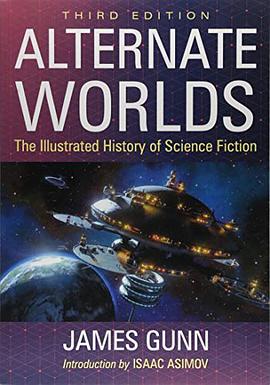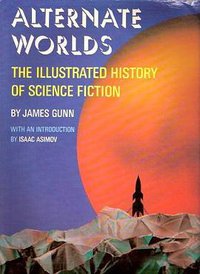Alternate Worlds
Douban
The Illustrated History of Science Fiction
[美] 詹姆斯·冈恩
overview
Alternate Worlds was first published by Prentice-Hall in 1975 as a coffee-table volume and soon became a classic, winning an award from the World Science Fiction Convention in Kansas City in 1976 (a "Hugo" before an award was presented in the non-fiction category and occupying a place in the reference shelves of libraries and the tables of thousands of fans. McFarland's more accessible edition brings the story of science-fiction's amazing development into a literature of our times up to date with a new chapter about what has happened in the genre and the world in the past forty years. As Isaac Asimov said, "We live in a science-fiction world, a world very much like the one we were writing about in the 1940s," It is a world of space flight, atomic energy and bombs, new inventions and technologies changing our lives and the way we think about the world and even the universe, a world of discoveries into the basic particles of matter and the farthest reaches of the universe, it is a world in which change is occurring at ever-increasing speed, so that new ways of observing and communicating are changing the world as we watch with amazement or dismay or revulsion, and changing humanity along with it. As the literature of change, science fiction has become increasingly meaningful, as it offers an opportunity for some to sample the future for habitability, as John Campbell once wrote, and for others to consider the human aspects of scientific and engineering possibility before it becomes part of human existence. And for the science-fiction reader it offers the opportunity to experience a wondrous future that he and (more frequently in this days) she may never get a chance to observe in person-the colonization of Mars, for instance, and the first interstellar flight, Of course there is also the possibility of catastrophe and apocalypse. Science fiction is written to expose their dangers and immunize humanity against their possibilities. The world has begun to recognize science fiction in a myriad of ways, from incorporating its visions in products, visual media, and huge conventions to seizing on its inspiration for future ventures into the unknown. As Alvin Toffler wrote in Future Shock, science fiction in a prophylactic against what he called "the premature arrival of the future." and William Gibson wrote, "the future is already here; it's just unevenly distributed." Alternate Worlds relates the way in which science fiction developed from early myth and fancy into the complex literature of today's world as the world itself was changed by exploration, science, and technology.
contents
Preface 1
Science Fiction, I Love You (Isaac Asimov) 5
1.The Shape of the Present 9
2.In the Beginning 23
3.Toward Verne: 1800–1885 37
Between pages 50 and 51 are 8 color plates with 16 photographs
4.A Victorian Engineer: 1828–1905 51
5.The Birth of the Mass Magazines: 1885–1911 66
6.Prophet of Progress: 1866–1946 77
7.The Rise of the Pulps: 1911–1926 97
8.That Amazing Decade: 1926–1936 113
9.The Expanding Universe: 1930–1940 128
Between pages 144 and 145 are 16 color plates with 46 photographs
10.The Astounding Editor: 1938–1950 145
11.The Big Boom: 1940–1955 171
12.Alternate Worlds: 1949–1965 195
13.The Shape of Things to Come 212
14. The Shape of Things That Came: 1975–2016 231
Appendix 1: Science Fiction Themes 251
Appendix 2: A Basic Science Fiction Libary 254
Appendix 3: A Short History of Western Civilization,
Science, Technology and Science Fiction 267
Index 293

